#Compostable Resins
Explore tagged Tumblr posts
Text
Biodegradable Products Manufacturers - Greendot Biopak
Greendot Biopak is a leading manufacturer and exporter of high-quality 100% biodegradable products in Gujarat, India. We specialize in producing environmentally friendly, compostable products that help reduce plastic waste and promote sustainability. Our product range includes disposable bags, shrink film, biodegradable resins, and compostable cutlery. These products are designed to decompose naturally, leaving no harmful residues behind. By choosing Greendot Biopak, you contribute to a cleaner environment and support eco-friendly practices. Our commitment to quality and innovation ensures that you receive the best biodegradable products that meet your needs and help protect our planet. Visit our site - https://www.greendotbiopak.com/
#Biodegradable Products#Biodegradable Plastic Bags#Biodegradable Material#Compostable Garbage Bags#Biodegradable Food Packaging#Compostable Resins#Compostable Plastic#Compostable Plastic Bags#Biodegradable Product Manufacturer#Disposable Bags Manufacturer#Disposable Garbage Bags Manufacturer#Sanitary Disposal Bags Manufacturer#Biodegradable Products In India
0 notes
Text
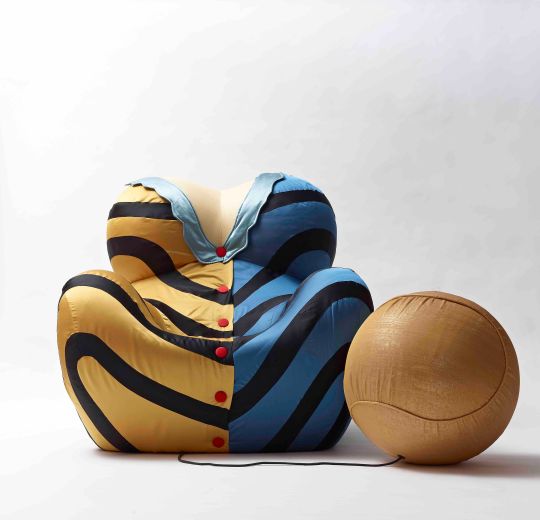
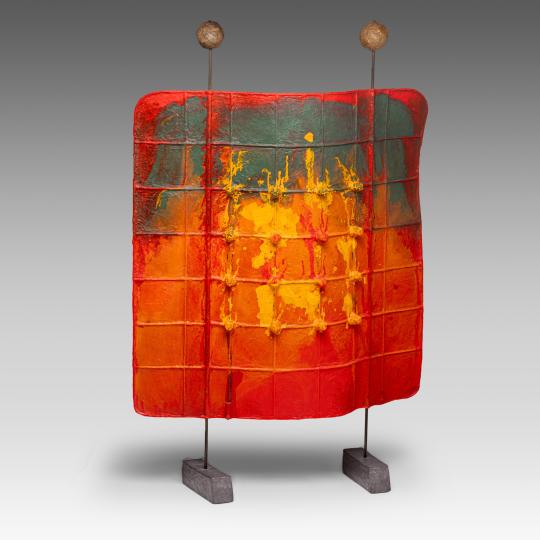


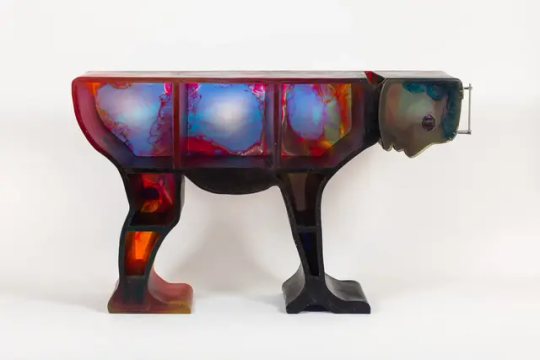
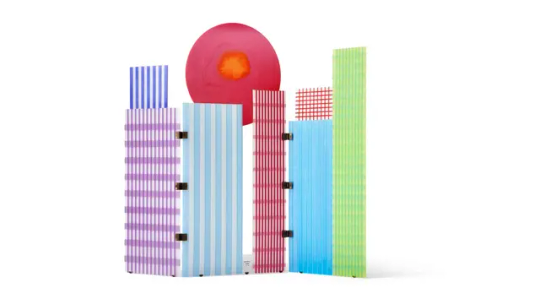




Gaetano Pesce (8 November 1939 – 3 April 2024)
Moving against the stream of rational, functional modernism in the 1960s and early 70s, Mr. Pesce experimented with materials and production methods to create furniture pieces imbued with political or religious meaning for brands from Cassina to B&B Italia.
Many would go on to become icons of Italian design including the Up5 chair – an innovative vacuum-packed chair designed to resemble a female prisoner – which he designed for B&B Italia precursor C&B.
Pesce moved to New York in 1983 and began to move away from mass production to create "standardised series" in everyday materials like resin, adapting conventional production techniques to create varied and imperfect outcomes.
The result are pieces such as the 1884 Pratt chair, which toe the line between functional design and decorative art, helping to create a new category that would later become collectible design.
Mr. Pesce was born in the Italian city of La Spezia in November 1939, only two months after the start of world war two.
As was common at the time, he trained in both architecture and design, studying first at the University of Venice and later at the Venice Institute of Industrial Design.
Among his architecture projects is the Organic Building in Osaka from 1993, with its plant-covered facade made of orange fiberglass that served as a precursor to today's vegetation-covered green walls.
But Mr. Pesce's most pioneering and well-known work happened in the world of design. In the late 1960s, he became one of the leaders of Italy's Radical Design movement, rejecting modernism's rigid focus on forms dictated by function.
Instead, Pesce focused on the idea that functional objects, much like art, could carry a deeper message.
One of the most famous examples is the controversial Up5 chair from 1969, which manufacturer B&B Italia describes as "the first product of Italian design with a political meaning".
Rest In Power !
"Up 5 & 6" Dressed Up Chair & Ottoman, 1969 – 2014, Polyurethane foam, fabric, Height: 40.5 in (102.87 cm)Width: 47 in (119.38 cm)Depth: 51 in (129.54 cm)Seat Height: 16 in (40.64 cm),
“Square Airport Lamp” (1986/1994). Photography by Elizabeth Carababas/The Future Perfect. Light sculpture consisting of a flexible rubber membrane studded with small light bulbs. Although made from a mold, no two lamps are alike, due to the imperfections that arise from the hand-mixing and pouring of colored urethane. H 92 - W 65 Cm,
"Feltri" Armchair for Cassina, 1980 -1989, Felt, Fabric, Resin, Width: 156 cm, Depth: 80 cm, Height: 129 cm, Seat height:42 cm, Courtesy: Oldera,
"Pratt Chair #7," 1984 2018 (purple), 2018, Transparent polyurethane, :93 x 53 x 53 cm. (36.6 x 20.9 x 20.9 in.),
"The Cabinet of The Tired Man," 2018, Photo: Courtesy of Salon 94 Design and Gaetano Pesce,
"Tramonto a New York" three-door screen, for Cassina, Made of coloured resin, hinges and feet in burnished brass, Width: 221, Height: 199,
"Organic" Building, Osaka, Japan, Completed in 1993 to embody the corporate ideal of Oguraya Yamamoto Co., Ltd,
"La In-Portante" Modular Bookshelf from the "Abbraccio" Series, 2010. Comprising 57 adjustable polyurethane resin shelves. Produced by Le Fablier, Italy. Polyurethane resin, painted wood, lacquered metal, 86½ x 118¾ x 16⅞ in. (219.7 x 301.6 x 42.6 cm) Courtesy of Sotheby's,
La Michetta Modular Sofa,Compostion of 8 by Meritalia, Structure in Lacquered Wood Seat with Elastic Belts, Flexible Polyurethane & Fiberfill Padding, Dimensions: W370 x D245cm,
Unique 'Ireland' table, Made of polyurethane and metal. The table was made and exhibited in 1996 by Gallery Mourmans, Knokke-Zoute, Belgium. It was part of a series of 'EU tables', where all 15 member countries were represented as a table, in this case Ireland. The top of the table has the shape of the outlines of the country and it stands on legs in the shape of question marks. W.80.71 in;H.28.74 in;D.57.09 in; (W.205 cm;H.73 cm;D.145 cm), Courtesy: Incollect.
#art#design#sculpture#furniture#seat#chair#forms#cassina#B&B#polyurethane#incollect#ireland#modular#bookshelf#table#fiberglass#sofa#gaetano pesce#rip#rip gaetano pesce#screen#iconic#up5#UP6#political#pratt chair#feltri#tramonto#new york
61 notes
·
View notes
Text
SiliNOT! Testing and Review
Since I run a lot of casting workshops, I've had several people in the costuming/maker community ask me my opinion on SiliNOT!, a relatively new product advertised as a budget- and eco-friendly moldmaking alternative to silicone, urethane, and other single-use materials.
I finally bought a couple of bottles to play with, so I did a test project. My experience and findings are below! (It's not a recipe blog, but if you want to skip the play-by-play and get to the TL;DR, it's under the big "In Summary" header near the bottom.)
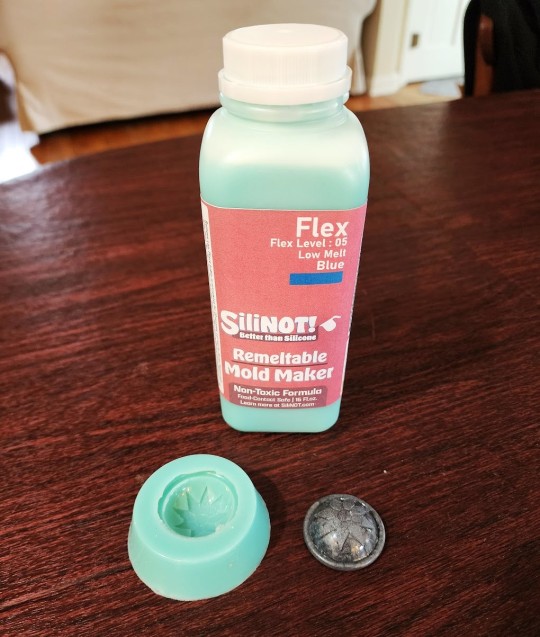
First, if you aren't familiar with this material, SiliNOT! is a remeltable, reusable medium for making molds. Though its exact ingredients are not disclosed, it purports to nontoxic, food-safe, and compostable. It melts in a household microwave or double boiler and solidifies at room temperature (or in a refrigerator/freezer for faster results). The website is https://silinot.com/.
(I am not an affiliate, and have no connection to this company apart from having made one retail purchase from them. I just have a lot of casting experience and like trying out new products.)
The Positive Original
I’m still in the middle of a Vincent Valentine build, so I decided to test the SiliNOT! on his custom buttons. My original is a stack of various nonporous materials: an antique (probably Bakelite) coat button, an epoxy resin dome I cast using a mold I already had in my library, and some engraved Worbla’s Pearly Art for the raised detail. The button shanks won’t be added until the final casting, so the original can be mounted flat for the moldmaking process.
Sample Worbla on the left; completed button stack on the right:
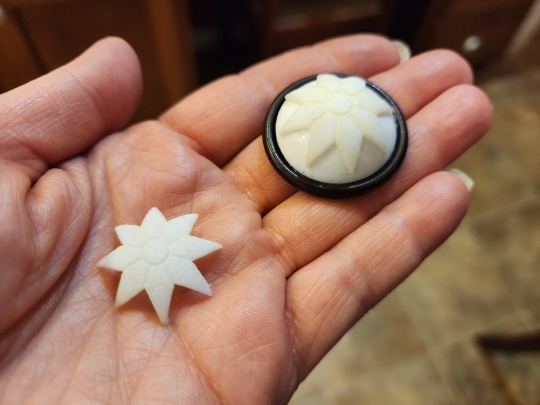
The Mold
I built the mold container the same way I do for silicone pours, with the flat back of the button fixed to a styrene plate and a cylinder (actually a small paper cup with the bottom cut off) surrounding it for the walls. The lip of the cup is sealed all the way around with Monster Clay to prevent leaks.
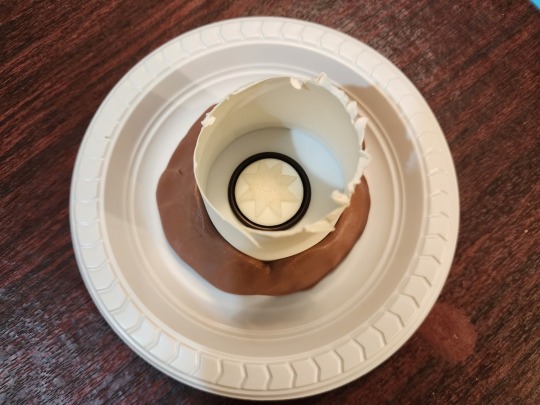
Heating and Pouring
The SiliNOT! didn’t take long at all to heat up; I did maybe four or five 20-second bursts before it was completely fluid. The bottle does get rather warm, so hand protection isn’t a bad idea. If you have heat-resistant gloves, you can use those; I was working in my kitchen (yay for nontoxic stuff!), so I just grabbed an oven mitt with a silicone grip.
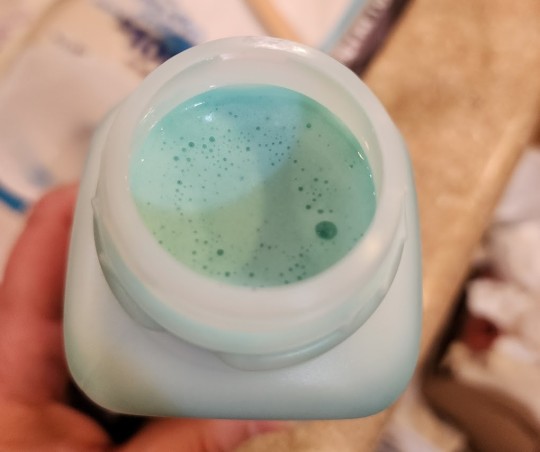
The melted SiliNOT! looks a bit like Luke Skywalker’s blue milk. It’s about the consistency of a yogurt smoothie and likes to pour in a thicker stream compared to silicone. While silicone can be stretched into a thin ribbon for delicate pours or chemically thinned with solvent for really tricky jobs, SiliNOT!'s viscosity is dependent on temperature and never seems to get quite as thin as silicone.
I’d automatically made my mold compact to conserve material (not really a concern with a reusable moldmaking material like SiliNOT!, but after using silicone for more than a decade, I’ve trained myself to be as efficient as possible), so the walls of my mold container were only about half or three quarters of an inch from my object. Because the target was so narrow, I found it difficult to accurately fill from the lowest area of the mold with the SiliNOT! The heavier pour also means more air can get trapped in or under the material.
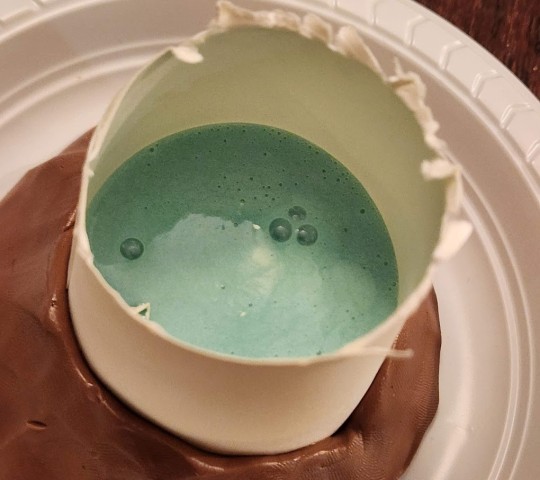
Bubbles are one of the areas in which SiliNOT! is decidedly inferior to silicone. SiliNOT! has higher viscosity, so bubbles don’t want to rise to the surface without vigorous tapping, which can distort the mold edges or affect leveling depending on your mold container. The bubbles that do make their way to the surface are difficult to pop, even when poked with a sharp implement. Heat gun degassing doesn’t have much effect.
Since the bubble surface cools and skins over quickly, I actually had to use a tool and scoop some large bubbles completely out of the mold to allow the surface to level. Critically, the SiliNOT! is opaque, so you can’t spot bubbles clinging to the surface of your original. (This is why my first mold was a reject, and I had to repour. More on that below.)
Hardening
Once the surface had set, I carefully moved the mold into the refrigerator to cool faster. Here’s another area where some types of silicone can have an advantage: I typically use fast-curing Smooth-On products (because I always have random quantities left to use up after our casting workshops), so I rarely have to wait more than half an hour for a silicone mold to cure, regardless of its size or mass.
The SiliNOT! has to chill completely before handling, though, and discharging that amount of heat requires a fair amount of time even in a cool environment. My mold was pretty small, maybe 2 1/2” wide by 1” deep, and it still took around 40 minutes to cool completely. A larger, deeper mold could hold considerably more energy in the center, and might have to be left in the freezer for a couple of hours before use.
Demolding the Original
When the mold was completely chilled, I removed it from the refrigerator and popped it off the plastic plate I’d used for the base of the mold. The texture was very different from what I’d expected: Unlike other meltable materials (Monster Clay, et al.) that have a firm surface when cool, the SiliNOT! remains tacky, which means it promptly collects any debris that crosses its path. In my case, this meant I had to pick dog hair off the surface throughout the casting process (and I don’t want to think about what would happen if glitter had contaminated the work space).
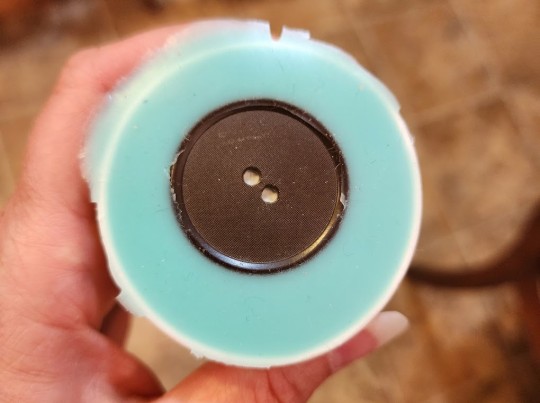
I’d used a paper cup for my mold walls, which usually works fine with fast-curing silicone. But the SiliNOT! must have a high oil content, because the cup absorbed some of it:
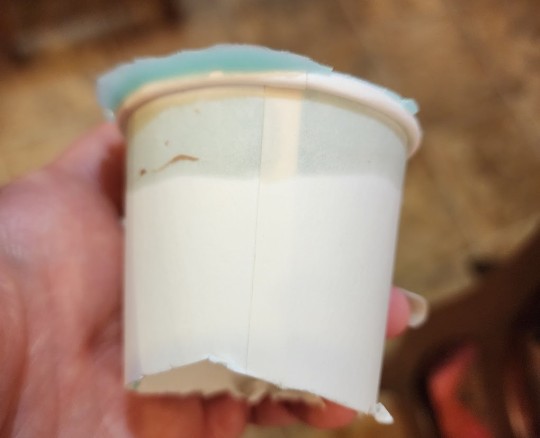
Lesson learned; use only nonporous containers with this stuff.
The SiliNOT!! really wanted to cling to the edges of my original, so I had to go slow at first to avoid tearing the thin flanges of the mold off. However, it did demold nicely from the smooth surfaces, and preserved texture very well. You can see the Worbla pebbling and the engraving channels clearly in the mold (as well as some dust and dog hair, because I made the mistake of setting it down briefly):
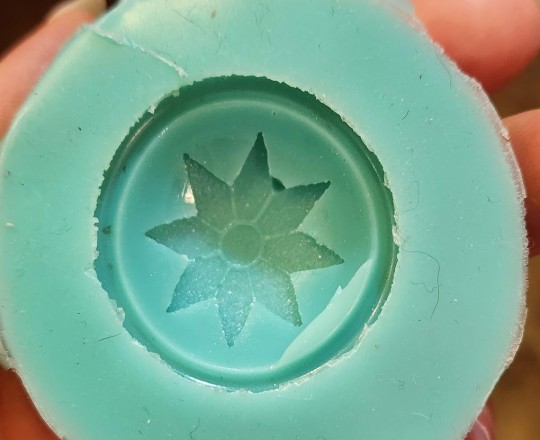
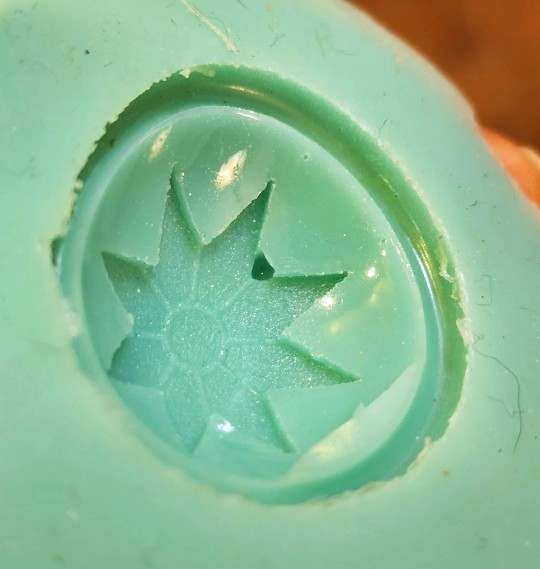
Unfortunately, as you can see, a large bubble had stuck to my original and created a pit in the mold, so I decided to do a second mold pour. I figured I’d tear up the failed mold and put the pieces back in the bottle to remelt… and discovered I couldn’t. The mold would stretch and twist, but not tear. It also seemed to return to its original shape relatively faithfully. Here’s a video of me manhandling the mold:
As you can see, the SiliNOT! has much better stretch and recovery than many silicone products (there are silicones that stretch well -- some of the Dragon Skin products come to mind -- but they’re not typically marketed for moldmaking). This means it’s likely well suited to casting objects with moderate undercuts or oddly-shaped bits that need the mold to stretch during demolding.
You can cut the SiliNOT! easily with scissors, which is the recommended method for getting it back in the bottle when you’re ready to remelt.
Take Two
Using what I’d learned from the first pour, I did the second one inside a hard plastic ramekin. This gave me a bit more room to pour into the floor of the mold, reducing the bubble risk, and also eliminated the porous paper cup that had absorbed oil. I still had the issue with bubbles that didn’t want to pop, but there were fewer of them this time.
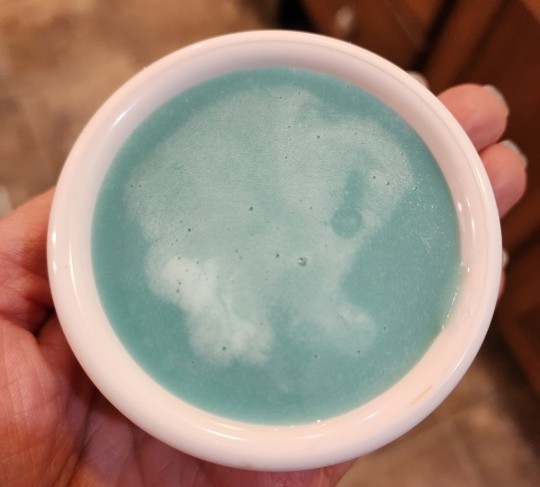
The ramekin made for a much cleaner mold, buuuuut there was ANOTHER BUBBLE right in the middle of the design. >.<
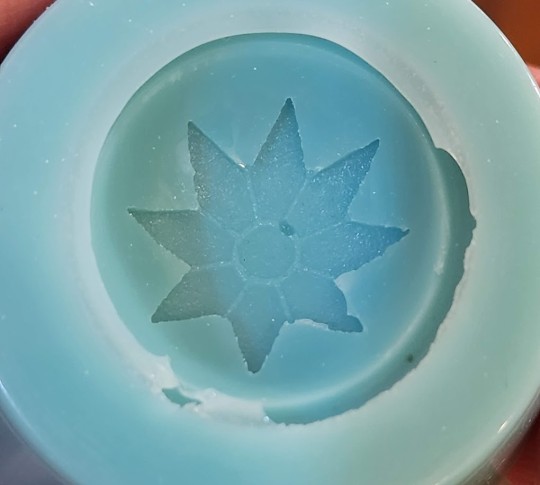
Take Three
Lather, rinse, repeat. Or in this case, melt, pour, chill.
This time I heated the SiliNOT! as much as I dared and did the absolute slowest, narrowest pour I could manage, giving the air extra time to escape as the mold was filled from the bottom. The risk with stringing out the pour like this is that in a thinner stream, the heat escapes faster, leading to uneven viscosity as the liquid fills the mold. I don’t think that’s a major problem for this particular piece, but it’s something to pay attention to as regards leveling and degassing, especially for larger molds that will take longer to fill.
The result of pour three:
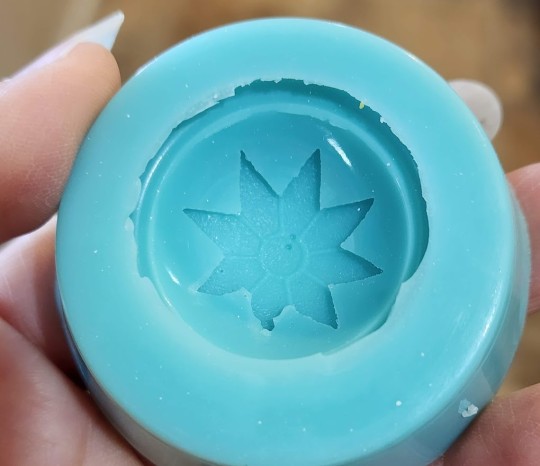
/siiiiigh/ Well, at least the bubbles are smaller, this time. They may not show up enough to matter in the final cast. I’ll give it a try.
Casting
I had leftover workshop resin that was getting on toward the end of its shelf life, so I used Smooth-On Smooth-Cast 300 for my initial resin trial. It’s an opaque white resin with about a 10-minute cure time (the fast turnaround is why we use it for workshops).
Before pouring, I had to do a little mold cleanup where the SiliNOT! had managed to sneak under the edge of the Worbla (I think I’d loosened the corner of the star from prying it out of so many molds), but since the SiliNOT! stretches so well, it was pretty easy to invert it to get little scissors down into the bottom of the depression.
For the first cast, I didn’t use anything but the resin in order to get a baseline. Ideally I’d like to cold cast or dye the resin so I don’t have to worry about paint chipping, but since I’m doing a trial here (and need multiple buttons anyway) I figured some plain white extras wouldn’t hurt.
So, my first cast…
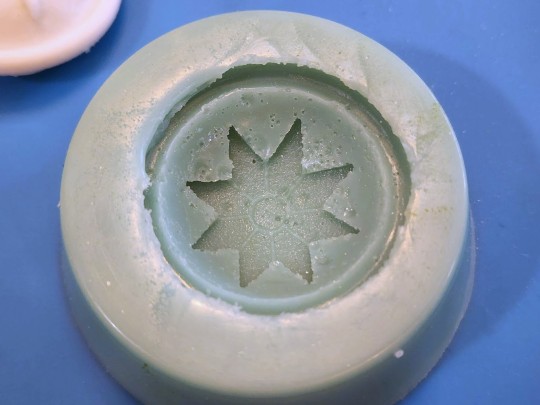
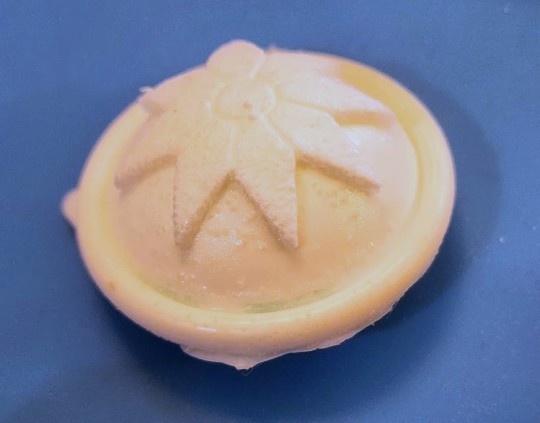
…smacked into a big problem, which I probably should have seen coming: The resin I’m using is a fast cure formula, which means it discharges a fair amount of heat as it's going through that rapid chemical reaction -- enough heat to melt the SiliNOT!, as it turned out. When I tried to demold it (after giving it a few extra minutes beyond label time to be sure it was done), the surface of the mold had melted to the resin and even embedded itself in a few places. It’s difficult to see the resin detail in the photos (my camera went into white balance panic mode with all the shades of white and blue), but you can see how pitted the formerly-smooth mold surface is.
In fairness to the SiliNOT!, the bottle does say that you should put the mold in the freezer for half an hour before casting high-temperature materials. But I assumed high-temperature material was something like candle wax or melted chocolate, rather than ordinary resin. (And the mold had just come out of the refrigerator.)
So, on to pour FOUR of the SiliNOT! mold…
Take Four
NGL, this is getting a little old. >.<
Fourth mold definitely needed some cleanup around the edges, and there are still a couple of tiny bubbles I can’t seem to get rid of, but it’s good enough for a test. (I’m starting to despair of using these for actual production, given how many times I’ve had to redo the molds because of bubbles...)
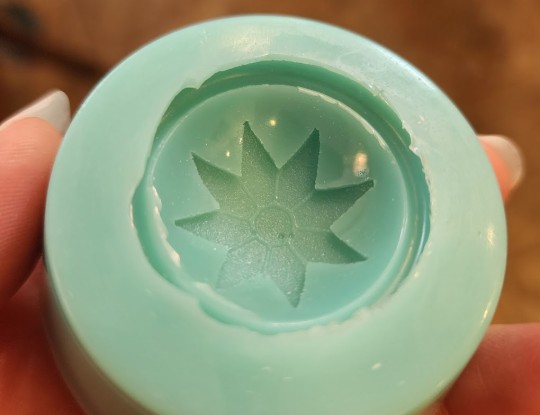
Deep in the recesses of my basement, I found some transparent epoxy resin with a 24-hour cure time -- much slower and lower-temperature than the Smooth-Cast. Since it cures clear, I went ahead and mixed in some metallic powder pigment on the off chance that I get a usable button out of this one. I had excess resin after mixing, so I poured that into my first mold, which has a bubble in the design but is otherwise fine. Two test pieces are better than one, right?
Results
Here are the results of the slow-curing resin out of mold #4:
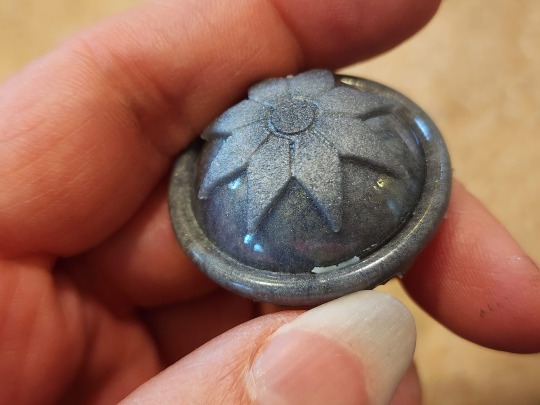
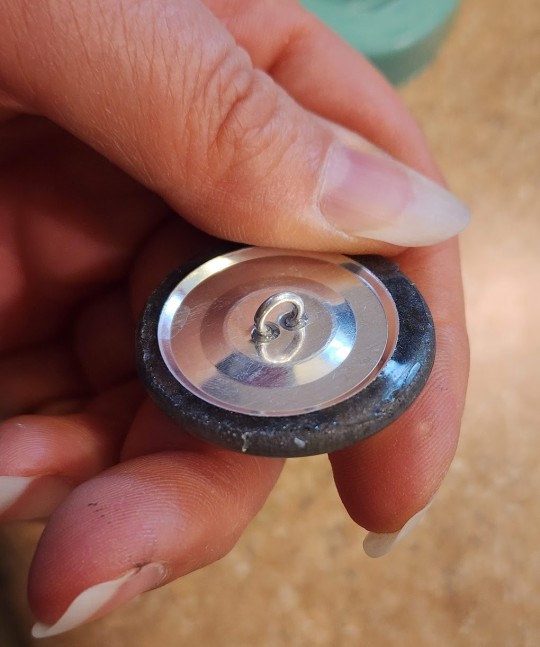
Finally, a (mostly) clean cast!
As you can see, the detail reproduction is excellent -- certainly on par with the pulls from the silicone mold I ended up making while waiting on this set to cure (purely for time reasons; I couldn’t afford five days to cast the buttons using slow-curing resin, and with a silicone mold and fast-curing resin I could get them all done within a couple of hours).
However, you can also see a few spots where bits of the SiliNOT! embedded themselves in the final cast. Part of that may be due to design flaw in the original; I didn’t want to glue anything permanently to the antique button, and that resulted in a tiny gap between the button and the resin hemisphere. Silicone has enough strength to resist tearing out in that kind of area, but apparently the SiliNOT! doesn’t. The bits of mold around the outer edge seem to have stuck just to be difficult, as there was no structural reason for those to have become embedded in the resin. This means the mold could be damaged by successive casts, reducing its usable life and accuracy.
Still, the mold definitely produced decent results for a first cast, and a different shape might not have had as much of a problem with tearing off mold parts. The slow-curing resin is a bit of a limitation, but not a unique one (I use this same epoxy resin for any glass-clear casts I do, and only use the Smooth-Cast 300 for opaque items or things I need very quickly). I don’t personally use UV resin, but I’d be curious to learn how it performs with the SiliNOT!
IN SUMMARY:
Here’s the TL;DR on SiliNOT!
Pros
Cost effectiveness. This is the most obvious advantage of SiliNOT! over silicone; it’s (theoretically) infinitely reusable, and even with natural attrition/inevitable contamination from use, you can likely get over a hundred pours out of a bottle. That's a lot cheaper per use than silicone.
Non-toxicity. SiliNOT! is touted as food contact-safe, so you don’t have to panic if you get it on your skin or kitchen counters. While platinum-cure silicone is also relatively harmless (some varieties are labeled for food or life casting), other common moldmaking materials such as tin-cure silicone or urethane are not. (NOTE: Since the company is very hush-hush about what actually makes up the SiliNOT! secret formula, I do not know if it might release any vapors or fumes that would be irritating or harmful to pet birds. In general, I advise not doing any kind of casting around birds.)
Eco-friendliness. This is the biggest draw for me personally: Given the number of casting workshops I run and all the things I sell commercially, I have constant guilt about the amount of waste I generate for creative projects. In most areas of life I’m an aggressive reduce/reuse/recycler and try to use organic materials instead of synthetics whenever possible, so a mold that’s reusable and compostable is very appealing.
Ease of use. It’s honestly pretty hard to mess this up -- just microwave according to the directions and pour. No measuring, no A/B mixture, no concerns about chemical contamination from latex or sulfur, etc.
Shelf life. Unlike silicones, which have a shelf life of anywhere from six months to three years depending on storage conditions, the SiliNOT! purports to be shelf-stable. It's compostable, so don’t bury it in your yard, but otherwise it appears that it could be kept on hand for years.
Cons
Bubbles. Honestly the most irritating thing about this stuff for me. I’m used to being able to see bubbles forming as I pour, tap them to the surface, and remove them. The fact that I poured four molds of the same object and never once got one without bubbles is super irritating.
Stickiness. I’m not a big fan of the tacky surface texture, and while I haven’t done any cold casting yet, I can imagine that it would be very difficult to clean out any pigment or mica powder that got where you didn’t want it. I probably wouldn’t use this for any kind of cold casting that required isolated colored areas or changing colors between casts.
Set time. The SiliNOT! may take longer to cool than a fast silicone would to cure when dealing with larger molds, so it’s not ideal for projects with a really tight turnaround. (But cosplayers would never be casting something the night before a con, right? We always plan ahead and never, ever procrastinate!)
Library life. The SiliNOT! may or may not structurally degrade over time the way urethane, latex, and tin cure silicones do, but I noticed even in my very limited casts that it was prone to having tiny bits of the mold (particularly at edges) stick and pull off. While I keep most of my platinum silicone molds for years and reuse them, I don’t feel that the SiliNOT! molds would hold up to repeated casting, and they’re far more sensitive to ambient temperature, so they’re probably best used for short term only. (I also wonder about the possibility of oil leaching out in long-term storage.)
Comparative Ranking
Ranking it against other mold-making materials, I’d place SiliNOT! below platinum-cure silicone in terms of performance, but maybe somewhere in the neighborhood of urethane and tin-cure silicone. It's definitely superior to latex. (Though to be honest, I'd rank Play-Doh above latex. I hate working with that stuff.)
Factoring in cost and environmental impact, it beats out urethane and tin-cure silicone. I'm still not sure if I'd rank it above platinum-cure silicone, though... Silicone costs much more and isn't eco-friendly, but the performance and lifespan is significantly better, so it still makes more sense for some projects.
Alginate is another type of material entirely, but in some ways SiliNOT! is comparable to it -- both are more cost-effective than silicone, both are biodegradable, both are skin safe, and both have long shelf lives. But SiliNOT! is easier to use for beginners than alginate, which has to be mixed to the right consistency and has an extremely short lifespan once poured.
Overall, I would recommend SiliNOT! for:
People who want accurate, non-shrinking molds but don’t have the budget for platinum-cure silicone
People who are committed to eliminating waste from single-use materials, and are willing to trade off a little performance for a more eco-friendly material
Projects with smooth surfaces and no indentations/sharp edges/undercuts where bubbles might stick (e.g. cabochons; simple geometric forms)
Projects where you need only one or two casts of something, rather than many casts from the same mold
Casting oddly-shaped pieces around which the mold needs to stretch in order to demold
Use with slow-curing resins that do not generate much heat
I would NOT recommend SiliNOT! for:
Extremely complex or detailed pieces, or pieces with a lot of surface texture that bubbles might stick to
Two-part molds
Projects requiring many identical casts out of the same mold
Molds that you intend to add to your library for future or repeat casting
Use with fast-curing resins, melted wax, melted Monster Clay, or any other material that emits heat
Cold casting with precise color application
My Overall Opinion
It's... okay? I will almost certainly keep SiliNOT! in my toolkit for certain specific applications. It's MUCH cheaper over the long term, I love the idea of recycling mold material, and there are some projects for which it will likely perform very well (those listed in the above bullet points). I will also admit that three days of working with it does not constitute a comprehensive familiarity with the product, and it might be the sort of thing that you get better at working with after more practice. (Just learning how to eliminate bubbles would go a long way toward making me adopt this for more projects!)
However, I don't quite buy the "better than silicone" tagline. It's definitely more difficult to get a perfect result, and there are some projects for which platinum-cure silicone is always going to be more reliable (e.g. high-temperature casting, mass production, large-scale life casting).
For those looking for a recommendation of whether or not to buy, I'd say look at your project budget and the applications for which you're going to be making molds, and let those factors guide which mold material you go with. People doing some kinds of projects are likely going to find this a godsend, while those doing different projects would probably hate working with it.
39 notes
·
View notes
Text
This video describes a way that the leaves of a pineapple plant can be used after the harvest.
Pineapple leaves can be turned into a fiber which is then turned into yarn or a leather substitute. Pineapple fiber has been woven into clothing since the 17th centaury. A labor-intensive process, machines can now automate most of the work of turning the raw leaves into fiber. This yarn is biodegradable and from a renewable resource.
About thirty years ago, Carmen Hijosa invented a product called Piñatex. A leather substitute, the fibers of pineapple leaves are combined with a cornstarch derivative called polylactic acid. Polylactic acid is from a renewable resource (corn) but degrades poorly outside of commercial composting facilities as it needs temperatures of 140 °F to break down effectively. The fiber/polylactic acid combination is then coated in a petroleum-based resin for strength and durability. So while 95% of the process uses biodegradable products, the final product of Piñatex is not biodegradable and has the same waste effect on the environment as plastics.
However, compared to chrome tanning of animal leather, a process that is used for 85% of all leather products, the effects of Piñatex may be less detrimental to the environment if properly disposed of and composted in a commercial facility. If done properly, vegetable tanned leather seems to be the best for the environment in our current society out of the three.
So while this is very admirable and gets rid of a waste product that is otherwise normally burned, like all things, it stills affects the environment negatively and you have to go by your personal morals of what environmental impact is most important to you when choosing what product to consume.
50 notes
·
View notes
Text

Putting an end to plastic separation anxiety
Bio-based plastics such as polylactic acid (PLA) were invented to help solve the plastic waste crisis, but they often end up making waste management more challenging. Because these materials look and feel so similar to conventional, petroleum-based plastics, many products end up not in composters, where they break down as designed, but instead get added to the recycling stream by well-intentioned consumers. There, the products get shredded and melted down with the recyclable plastics, bringing down the quality of the mixture and making it harder to manufacture functional products out of recycled plastic resin. The only solution, currently, is to try to separate the different plastics at recycling facilities. Yet even with the most high-end, automated sorting tools, some biobased plastics end up contaminating the sorted streams.
Read more.
16 notes
·
View notes
Text
I'll want to break down the chicken and beef into pre-marinaded freezer baggies with any roots or beans or sauces paired with them in a lil bundle of baggies, that way meals become as simple as popping a baggie set into a cast iron in the oven or on the stove. The last of the current priority garden, home, and body ingredients are in the mail, and I'm just waiting until I have the last of my salts and amino acids to mix them up.
Upcoming projects:
1) add compost cultivator to The Stacks now that there is a sizeable hay patch and an existing decomposition culture to support
2) Start tree seed trays (wild plum and black cherry)
3) Start greens seed trays (amaranth, turnip, beet, collard)
4) start shrub seed trays (Alleghany blueberry)
5) start wildflower seed trays (flax, marshmallow)
6) bury seed trays in coco coir and compost when The Stacks are fully decomposed
7) infuse olive oil with shea butter cubes, resins, cracked seeds, and salts in pourable cruets
8) break down chicken and beef into ready-prep single meal and bulk meal portions and freeze (burger/meatloaf mix, chili mix, carne asada, carne criolo, buttermilk chicken for battered cutlets, pulled chicken and ranch for pizza root-fries, kung pao chicken, green curry chicken, pulled chicken for matzoh soup, meatballs, lemon garlic chicken, ground beef crumbles, Date Night Steaks, sliced roast beef packets, jerky, BBQ for beans, dumpling filling, seasoned battered chicken for fried chicken strips and cheesy chicken pasta/veggie-noodle lasagnas, etc)
9) sauce tomatoes and freeze
10) bake a round of washing soda
11) ferment some rice for washing cakes and scalp scrubs
12) mix laundry detergent (epsom salts, resin infused oils, seed infused oils, washing soda, hand soap)
13) mix body scrubs
14) mix and set washing cakes
15) mix and jar scalp scrubs
16) mix and jar hair cremes
17) mix and jar hair masques
18) mix and jar skin masques
19) mix and bottle serums
20) mix and bottle texture spray
21) mix and jar bath salts
22) deep clean kitchen (wash counters, wash sink, treat drain, sweep and mop floors, wash cabinetry, wash appliances, run cleaning cycles on oven and dishwasher, clean out traps and catches, wash trash can and deoderize, empty and sanitize recycling bag, clean cat cozies, sanitize kitty meal plates, sanitize communal water fountain, sanitize water pitcher and replace filter, etc)
23) juice citrus (lime, lemon) and bottle/refridgerate
24) make citrus paste (lime, lemon) and freeze
25) make chimichurri base and freeze
26) make basil, garlic, and sesame paste and freeze
27) make kefir
28) make garlic confit and freeze
29) make caramelized onions and freeze
30) make pepper paste and pepper jelly and freeze
31) make pickles (onion, garlic, peppers, sundried tomato) and freeze
32) make curried carrot and lentil soup and freeze
33) make chicken stock and freeze
34) make kimchi
35) make samosa and empanada wrappers (corn masa pastry dough)
36) make dumpling wrappers (rice paper)
37) make and freeze dumplings, samosas, and empanadas (veggie mince, meat mince, kimchi and rice, Oaxaca and honey, Oaxaca and beans, Oaxaca and pepper jelly, curry chicken, veggie curry)
38) mix and bag sazon rice packets
39) prep herb and spice mix bottles
40) season and freeze root-fries and root-wedges
41) marinade and freeze veggie side dishes
42) air fry and package chickpea pops
43) make candied snickie snacks (nuts, jerky, coffee beans, carrots, citrus)
44) cut and batter Oaxaca strips for battering (seasoned lentil and rice flour) for paneer pakora and fried cheese sticks
45) cut Oaxaca strips for cheesy pastas
46) make and freeze queso fundido (Oaxaca cubes, peppers, garlic confit, coriander, oregano, paprika, chili pepper flakes, cumin, salt, cracked peppercorns, sundried tomatoes, shea butter curls, buttermilk, meatmince)
47) mix and freeze omelet/egg casserole mixes (queso fundido, onions, salt and pepper, fresh herbs, liquid whole egg mixed with buttermilk and rice flour, sundried tomato mince)
48) repot Pomegranate in compost and coco coir
49) identify and butcher the rooster
50) source scrap wood for laying nests, cat climbers, garden stakes, cat toys, chicken toys, carry/storage crates, etc)
51) mix dehumidifer/air filter pack for upstairs bathroom
52) deep clean upstairs bathroom (wash sink, wash floors, wash toilet, wash cabinetry, refill hand soap, wash counters, polish hardware, wash mirror)
53) wash towels and hang out to dry
54) wash blanket/bed linens and hang out to dry
55) wash clothes and hang up to dry in rounds of 2× outfits or 1× linens per basin
56) deep clean our bathroom (wash sinks, wash counters, sweep and wash floors, wash cabinetry and walls, refill deoderizer, clean shower, polish hardware, wash mirrors, refill hand soap, organize shower and sink products, wash toilet)
57) deep clean bedroom (take out trash bins, pick up floors, vacuum and sanitize carpets, wash walls, organize clothes, organize dog toys, sanitize dog meal dishes, wash and polish side tables/trunk, wash bedframe, sanitize mattress, change sheets and blankets)
58) vacuum and sanitize upstairs carpets
59) wash walls upstairs
60) clean guest bedroom (sanitize mattress, wash and replace bed linens and blanket, pick up floors)
61) move office couch to living room
62) move office desk/supplies to guest bedroom (for now)
63) plan a workout routine (minimum 2x gym days/wk for rowing and cycling and traction, min 2 home workouts/wk -> prioritize range of motion, balance, and gradual endurance building)
64) plan a hygeine routine (min 3x wash day/wk for skin, max 1x wash day/wk for hair)
65) organize my next round of plans
4 notes
·
View notes
Text
i like making bio degradable art because if i fuck it up so badly i can just throw a bunch of compost at it until it dies . if you fuck up a resin,what do you even do. probably have to exile yourself. i like some resin art though it can be very pretty.if you make pyramids you are going to hell though
2 notes
·
View notes
Text
How Compostable Garbage Bags Help Reduce Landfill Waste
Compostable garbage bags are a simple yet powerful way to cut down on landfill waste. Unlike traditional plastic bags that take hundreds of years to break down, compostable bags decompose naturally into non-toxic components, often within months. They're made from renewable materials like cornstarch or plant-based resins, which means less pollution and a smaller carbon footprint. When used to collect organic waste, these bags ensure the entire load can be composted efficiently. Choosing compostable garbage bags supports a cleaner planet and a more sustainable waste disposal system.
#CompostableGarbageBags#EcoFriendlyWaste#SustainableLiving#ZeroWaste#GreenDisposal#CompostableBags#PlasticFree#EcoWasteSolutions#ReduceLandfillWaste#BiodegradableAlternatives#WasteManagement#EcoConsciousChoices#SustainableWaste#EnvironmentFriendlyBags#GreenLiving
0 notes
Text
Swapping away from one-time-use Bottles & Sodas
Cold Brew Tea!
This is not resin or art related but the other day I talked about how I converted from drinking things in single use plastics (like water bottles) and even soda (cans/bottles) to loose leaf tea in reusable glass bottles. I wanted to touch upon that again and show what I mean by that.


Around last year in December, I got this 6-pack of glass bottles and I drink/cycle through 3 per day. I cold brew my tea in these compostable abaca fiber tea bags for 12+ hours. (Yes these are compostable, they do not contain any plastic or staples. Feel free to look it up. If they do contain those things, they are not compostable.)
[Those are OctoNation Stickers on the glass bottles, for Decor and because I 🐙💓 them.]
Here's a good article on Tea Bags: https://www.teamiblends.com/blogs/lifestyle/natural-synthetic-fiber-bags
I add about 1 tsp of stevia, splenda, monk fruit or whatever natural sweetener to each of these bottles. It's the right amount of sugar for my tastes but I feel like I could cut that down slowly. Cold brewing removes the usual bitterness you get from hot brewing tea incorrectly (or even correctly sometimes).
[I try to use local honey if it's a hot brew because local honey can help build an immunity to local sinuses/allergens.]


I also bought these huge air tight glass gallon mason jars to store all of my tea bags in so I could make them en masse, and grab them whenever I want. I have smaller containers for the flavors I have less of (because Tiesta, my go-to tea brand, has many flavors I love).
[Cold brews, in the Tiesta brand, I prefer are the Fruity Paradise, Blackberry Bellini, Peaches n' Green, and Maui Mango. The Strawberry Lemonade there is for someone I live with 🙃. Hot brews I prefer are Cozy Peppermint Cocoa, Cocoa Mocha Tiramisu, Fireside Spice, and Chai Love.]
Tiesta has so many flavors, it's worth getting a sample box from them if you're a tea lover, imo.
They do not sponsor me, nor am I an affiliate and I do not get anything for writing this post. I simply love their product and want to spread awareness about using less plastics. Besides, green tea is healthy for you in so many ways + it tastes yummy 🥰
Short Article about Plastic Pollution: https://oceana.org/our-campaigns/plastics/
0 notes
Text

Biodegradable Garbage Bags Manufacturers - Greendot
Greendot Biopak is a well-known company for biodegradable garbage bags manufacturers and exporters in Gujarat, India. These bags have an advantage in that they break naturally over time, as opposed to traditional plastic bags, which can survive for hundreds of years! Greendot Biopak cares about the environment, so offers a broad variety of eco-friendly products, not just bags. These products are made from organic items, so they are safe for the environment. Visit our site for buy - https://www.greendotbiopak.com/garbage-bag or call us at - +91-951-239-9155
#Biodegradable Products#Biodegradable Plastic Bags#Biodegradable Material#Compostable Garbage Bags#Biodegradable Food Packaging#Compostable Resins#Compostable Plastic#Compostable Plastic Bags#Biodegradable Product Manufacturer#Disposable Bags Manufacturer#Disposable Garbage Bags Manufacturer#Sanitary Disposal Bags Manufacturer#Biodegradable Products In India
0 notes
Text
Public Service Announcement: Epoxy Resins
Epoxy resin, widely used in crafts, is typically a two-part thermosetting polymer made from:
1. Epoxy (Part A) – usually bisphenol-A diglycidyl ether (DGEBA) or similar variants. This is the resin base.
2. Hardener (Part B) – commonly a polyamine or anhydride curing agent.
Chemical Breakdown:
• DGEBA (resin): Full name: Bisphenol-A diglycidyl ether. Formula: C₂₁H₂₄O₄. It’s a viscous liquid containing epoxide functional groups that react with the hardener.
• Polyamine (hardener): These are compounds with multiple amine groups (–NH₂), such as triethylenetetramine (TETA). They initiate the crosslinking reaction by opening the epoxide rings in DGEBA, forming a solid 3D network.
The Curing Reaction: is an exothermic reaction (releases heat) that leads to a hardened, durable plastic-like material. Once cured, epoxy resin is chemically resistant, clear (or tinted), and very strong—ideal for jewelry, river tables, coating art, etc.
Is Epoxy Resin Sustainable or Biodegradable?
No, traditional epoxy resin is not biodegradable, and it’s not considered sustainable.
Why not?
• Epoxy resins, especially those made from bisphenol-A (BPA), are petrochemical-based.
• After curing, the material forms a highly crosslinked polymer network, which is extremely durable and resistant to natural degradation.
• Microorganisms can’t break it down like they can with natural polymers (e.g. cellulose or starch).
How Long Does It Last?
• In the environment, epoxy resin could persist for hundreds of years, depending on conditions.
• It does not degrade under normal composting or landfill conditions.
How you can help:
Do not buy products (art, craft) made of Epoxy Resins.
If you have that kind of influence, call for a total ban on non-essential Epoxy Resin based products.
Spread the word!! Often, artists jump on a trend to make quick money or copy someone else if they’ve created something pretty without thinking about the sustainability aspect.
Ask agencies like Fridays for Future and Greenpeace to support such grassroots initiatives too.
#epoxy resin#artist beware#buyer beware#sustainability#environment#protection#art#art and craft#crafts
1 note
·
View note
Text
beyond icelebrities week 11 - part 2

Fast fashion contributes to my life through its overconsumption, exploitation and harm on the environment. The apparel industry is one of the most polluting in the world. In my early childhood, fast fashion shopping was more normalized and most of my clothes were from fast fashion brands. When I became a teenager I became more interested in thrifting from social media and so did many of my peers. It can be difficult to envision how harmful fast fashion is when the process of making clothes from start to finish often goes unseen, but we can see that the global climate is changing rapidly which directly impacts the health of everyone and the planet.
Some celebrity brands that are addressing sustainability include Lady Gaga’s Haus Labs. This is a list of clean standards on their official site:
• Made without more than 2700+ questionable ingredients including but not limited to: PEGs, Phthalates, Petrolatum, Mineral Oil, Cyclic Silicones, Sulfates, Parabens and potential carcinogens, endocrine disruptors and environmental toxins
• 'Clean at Sephora' certified
• Sustainably sourced, high performance formulas with skin-optimizing ingredients
• Cruelty-free
• Vegan
• Fragrance free
• We strive to use sustainable packaging materials – like glass, aluminum, cellulose and PCR resin – that are planet safe and reduce climate impact. All of our secondary cartons are 100% recyclable and compostable, made from FSC certified paper sourced from sustainably harvested forests.
Another sustainable brand is Ariana Grande’s r.e.m. beauty. The official site states, “ r.e.m. beauty products are Peta certified cruelty-free, vegan-friendly, and never tested on animals...only very happy human volunteers.”
Some fashion brands known for greenwashing that have partnered with celebrities in the past include H&M, Shein, and Primark.
A charitable act from artists Charli XCX and Billie Eilish:

3. The biotextiles mentioned above are great efforts towards sustainable fashion. I love how visually appealing they are and how the textures are defining natural features that you can’t get from other types of clothing. There’s almost a futuristic element, especially from the bioplastic made from algae. The mushroom leather video was quite fascinating, as it reiterated how sustainable and dynamic mycelium is.
In terms of viability, there needs to be stronger efforts for these natural eco-friendly materials to become more widespread. I think celebrity endorsements of these materials can not only help them become more well-known to the general public but create more of a demand that can lead to progressive change.
4.
Younger generations, more cautious about their fashion choices, could become the leaders in sustainable fashion.
From social media and in person interactions with my peers, there’s a clear shift in how we shop from clothes compared to older generations. More people thrifting is the main shift. The uniqueness of owning something from a thrift store that no one else has is appealing and combining that with overall sustainability is the reason why 95% of my wardrobe is thrifted. There’s no doubt that younger generations are leading sustainable fashion and have more resources now than ever to continue down the sustainable path.
Fast fashion is a worldwide issue, so it will require changemakers and disruptors in every country to transform the fashion industry.
International relations and changemakers are needed to transform the fashion industry. The amount of clothing that goes to waste is so large that it's incredibly difficult to put an image to what it looks like. It’s important to think outside of the country you’re in and contribute by helping other countries as well. I’m grateful that for years me and my family have helped donate clothes to those in need in the Philippines. Being a sustainable fashion changemaker doesn’t have to be a flashy heroic action, it can simply be donating or even having a conversation about it with others.
Pretty much every textile is recyclable, but not much of it is actually recycled.
Textile recycling should be more widespread. Oftentimes, the reusability aspect of clothes is a larger part of the conversation. I think back to my Sustainable Systems class where I remade a t-shirt into a grocery bag DIY style. It was an enjoyable process that I likely never would’ve done if I hadn't taken the class. I feel that textile waste, being the major issue it is, deserves to be taught about more in schools along with the reusability/recyclability of them. The solutions are much more accessible, it’s a matter of encouragement that needs to occur.
5. A few of my fav thrifted clothes/finds!!!



0 notes
Text
The Science Behind Nonwoven Textiles: How Innovation Shapes the Industry
Nonwoven textiles might not grab headlines, but they’re central to how modern infrastructure quietly operates. These materials skip the loom altogether—no weaving, no knitting—just fibers aligned, bonded, and pressed into forms that serve everything from hospital masks to highway underlayers. This post outlines the technical and industrial dynamics at play in nonwoven textiles, their historical backdrop, and where the science is heading next.
Understanding Nonwoven Textiles
Think of nonwoven textiles as engineered mats. Instead of looping yarns over and under, these fabrics come from fibers—synthetic or natural—that are bonded together through mechanical force, thermal processing, or chemical bonding. It’s an industrial shortcut that’s anything but crude. These fabrics are engineered for performance: filtration efficiency, moisture control, tensile strength, and more.
Common fibers include polypropylene, polyester, and biopolymers, each selected depending on what the final product needs to achieve. The alignment of fibers—randomized for softness or directional for strength—also affects the final structure. Bonding completes the process. Whether via heat, resin, or physical entanglement, this stage locks the web into a usable material.
Historical Context and Evolution
The commercial rise of nonwoven textiles kicked off in the mid-20th century, largely tied to wartime material innovation and the postwar consumer boom. With synthetic polymers like nylon and polyester becoming more accessible, industries started looking beyond weaving for high-volume, disposable materials.
Technologies like meltblown and spunbond enabled finer control of fiber size and layering. This meant products like surgical masks or geotextiles became not just feasible but reliable. Nonwoven products evolved from being disposable conveniences to industrial components with specialized functionality.
Fiber Selection and Material Science
Everything in nonwoven performance begins at the fiber level. Polypropylene is cheap and hydrophobic, ideal for hygiene applications. Polyester brings strength and thermal resistance. Cellulose-derived fibers like viscose add absorbency and are compostable under specific conditions.
Recent advances include fibers with intricate cross-sections, smaller diameters for higher surface area, or dual-polymer structures that respond to stimuli like heat or moisture. With sustainability under the microscope, materials like PLA (derived from corn) and lyocell are emerging in the mix. But these come with trade-offs in cost, strength, and compatibility with existing manufacturing lines.
Fabrication Techniques and Technologies
Dry-laid methods rely on mechanically aligning and layering fibers, which are then bonded. Wet-laid systems suspend fibers in water before draining and drying them into sheets. Spunbond and meltblown involve polymer extrusion, with fibers laid down directly from molten streams—ideal for fast, scalable production.
Needle punching uses barbed needles to physically tangle the fibers into a cohesive sheet. While it’s not as fast as spunbonding, it’s great for thicker, more durable products like automotive insulation or protective underlays. Composite methods like SMS (spunbond-meltblown-spunbond) combine strengths of each system.
Functional Enhancements and Applications
Most nonwovens get post-treatment. Want it waterproof? Hydrophobic coating. Need antimicrobial properties? Add a silver-based finish. Specific use cases drive these decisions. A crop cover needs UV resistance; a face mask needs breathability and filtration.
Applications span sectors. Hospitals use them for gowns and drapes. Construction integrates them into roofs and drainage systems. In agriculture, they’re laid across soil for weed suppression and microclimate control. They even show up in fashion—think disposable shoes or eco-tote alternatives. What unifies all of this is engineered performance, not aesthetics.
Environmental Considerations and Sustainability
Environmental critique of nonwovens tends to focus on their disposability. Most are petroleum-based and not easily recyclable. But change is underway. Biopolymers like PLA are entering the space, especially where composting infrastructure exists.
Recycling is tricky but not impossible. Post-industrial waste is already being reintegrated into production. For consumer waste, solutions are still in early stages. Energy and water usage are also areas of concern, particularly in thermal bonding and water-intensive wet-laid methods. Life Cycle Assessments are increasingly used to guide better material and process choices.
Market Dynamics and Industry Structure
The industry is global and segmented. Some companies handle everything from polymer sourcing to finished rolls. Others specialize in one part—say, filtration media or medical-grade fabrics. North America, Europe, and Asia-Pacific dominate production, but demand is rising in Latin America and Africa.
COVID-19 temporarily reoriented global capacity toward PPE. Post-pandemic, demand is shifting back toward hygiene, filtration, and construction, with a sharper eye on quality and environmental impact. Intellectual property—especially around fiber structure and machinery—is a differentiator. Compliance standards like ISO and ASTM govern product acceptability in regulated markets.
Innovation in Needle Punch Technology
Needle punching hasn’t stood still. Modern systems allow precise control over needle depth, density, and web layering. This enables products with varying textures and performance zones—one layer might resist compression, another might insulate.
Recycled content is increasingly incorporated without compromising quality, thanks to improved fiber handling and web formation controls. While not suited for lightweight applications, needle-punched products remain vital where structure and reuse matter more than breathability or thinness.
The Role of Advanced Manufacturing
Digitization is now integral. Automated systems monitor temperature, humidity, line speed, and bond strength in real-time. Predictive maintenance tools flag wear before breakdowns. Digital twins—virtual replicas of manufacturing systems—enable scenario testing without disrupting output.
Traceability platforms help companies meet regulatory standards and reassure clients. They also support small-batch customization, which is becoming more viable as brands seek specialized materials. The non woven textile manufacturers leading this charge are setting a new bar for process sophistication.
Emerging Frontiers in Material Development
Material innovation is heading toward multifunctionality. Smart textiles embed sensors or conductive threads into nonwovens for health tracking or temperature response. Nanofibers allow new levels of breathability and filtration. Hybridization—mixing synthetic and biodegradable fibers—is also gaining ground.
Sustainability is not just a moral stance but a product spec. That’s reshaping the manufacturing of non woven fabric. Cross-functional R&D teams are working on everything from enzyme-degradable polymers to solvent-free bonding techniques.
Final Notes
Nonwovens are neither glamorous nor new. But their quiet adaptability and scientific depth make them one of the most relevant industrial materials of our time. If the future of materials is smart, responsive, and sustainable, nonwovens are already halfway there.
0 notes
Text
How to Pick the Best Weed Seeds for Your Climate
Choosing the right weed seeds can make or break your grow—climate is the silent partner that decides if your plants thrive or just survive. Whether you’re cultivating indoors with total control or outdoors at nature’s mercy, matching weed seeds to your conditions is key to unlocking potency (20%+ THC), flavor, and yields (up to 20 oz/plant outdoors). From sunny summers to chilly basements, here’s how to pick the best weed seeds for your climate and set yourself up for a killer harvest.
Why Climate Matters for Weed Seeds
Cannabis isn’t one-size-fits-all—strains like Blue Dream or Durban Poison evolved under specific conditions, and their seeds carry that DNA. Temperature, humidity, and light dictate germination, growth, and bud quality. Pick weed seeds that mismatch your climate—say, a tropical sativa in a cold zone—and you’ll fight stunted plants or moldy buds. Get it right, and you’re harvesting 1.5-2 oz/ft² indoors or 15-25 oz outdoors. Let’s break it down by climate type.
1. Warm and Sunny Climates (Outdoor)
Best for: Coastal California, Mediterranean zones, or southern states—temps 70-90°F, long summers.
Ideal Weed Seeds: Sativas or sativa-leaning hybrids like Durban Poison (25% THC, 10-11 weeks flower) or Jack Herer (20%+, 9-10 weeks). These love heat and stretch tall (5-7 feet), soaking up 8+ hours of sun.
Why They Work: Long growing seasons (April-October) let them veg big, yielding 20-25 oz/plant by late fall. Heat boosts terpenes—think citrusy, spicy buds.
Tips: Plant in April-May, use well-draining soil (60% peat, 20% perlite, 20% compost), and water deeply but infrequently—top inch dry.
Watch Out: Humidity over 50% in flower risks bud rot—pick airy strains and prune lower leaves.
2. Cool and Short-Season Climates (Outdoor)
Best for: Northern U.S., Canada, or mountain areas—temps 60-75°F, short summers, early frost.
Ideal Weed Seeds: Indicas or fast autos like Northern Lights (18-22% THC, 7-9 weeks) or Blueberry Auto (18%+, 8-10 weeks total). Compact (3-4 feet), quick finishers.
Why They Work: They ripen by September-October (15-20 oz/plant), dodging frost. Cool nights enhance purple hues and resin—sweet, earthy vibes.
Tips: Start indoors March-April, transplant May, use mulch to retain heat—harvest before October chill hits.
Watch Out: Rainy falls can mold dense buds—choose mold-resistant strains and cover with tarps if needed.
3. Hot and Humid Climates (Outdoor)
Best for: Southeast U.S., tropical zones—temps 80-95°F, humidity 60-80%.
Ideal Weed Seeds: Sativa-dominant like Sour Diesel (25%+, 9-11 weeks) or Pineapple Express (20%+, 9-10 weeks)—airy buds fight moisture.
Why They Work: They handle heat and stretch (5-6 feet), yielding 20-25 oz/plant by late October. Humidity boosts fruity terpenes—pineapple, diesel notes pop.
Tips: Plant in raised beds for drainage, space 4 feet apart for airflow—neem oil keeps pests off sticky buds.
Watch Out: Bud rot and powdery mildew thrive here—avoid dense indicas unless you’ve got fans or defoliation skills.
4. Indoor Controlled Climates
Best for: Any region—tents or rooms with lights, fans, and heaters—70-80°F, 40-50% humidity in flower.
Ideal Weed Seeds: Anything goes—Gorilla Glue (25-30% THC, 8-9 weeks), Purple Punch (20%+, 8-9 weeks), or autos like Amnesia Haze Auto (20%+, 9-11 weeks).
Why They Work: You set the rules—18/6 veg, 12/12 flower, 600W LEDs/HPS—yielding 1.5-2 oz/ft². Match strain to space (compacts for tents, tall sativas for rooms).
Tips: Dial in climate—65-75°F late flower for purples, CO2 (1000 ppm) for THC. Train with LST for even light.
Watch Out: Costs ($500+ setup, $50-100/month power)—pick high-yield weed seeds to offset bills.
Key Factors to Match Seeds to Climate
Flowering Time: Short seasons need 7-9 weeks (Northern Lights); long summers fit 10-12 weeks (Sour Diesel).
Height: Indoors caps at 4-6 feet; outdoors handles 7+ feet—check strain specs.
Mold Resistance: Humid zones need airy buds (sativas); dry climates take dense indicas.
THC Goals: Warmth and light push potency—indoor control or sunny outdoors hit 25%+.
Where to Find Climate-Smart Weed Seeds
Online Seed Banks: ILGM (U.S., free shipping—Blue Dream, 24% THC), Seedsman (4,400+ strains—Durban Poison), MSNL (NY-based—Northern Lights). Filter by “indica,” “sativa,” or “auto.”
Breeders: Barney’s Farm (Glookies, 25%+), Humboldt Seeds (Blue Dream)—check strain climate notes.
X Buzz: Posts rave about Hypno Seeds’ fast autos for cold zones, NWSun on Strainly for $45 tropical sativas.
Checklist: Look for germination guarantees, strain details (THC, height, flower time), and reviews matching your climate—e.g., “GG4 killed it in my hot garage.”
Bonus Tips for Success
Test Run: Start 2-3 weed seeds—see what clicks with your setup.
Adjust: Indoors, tweak light; outdoors, use pots to move if weather shifts.
Harvest Right: 70-80% cloudy trichomes—climate won’t ruin potency if you time it.
Your Climate, Your Seeds
Picking the best weed seeds for your climate is about fit—sativas for sun-soaked summers, indicas or autos for short seasons, anything indoors with cash to burn. Warm climates crank out 20-25 oz/plant; cool zones hit 15-20 oz; indoors nails 1.5-2 oz/ft² with control. Match your weed seeds to your temp, light, and humidity—whether it’s a tent or a field—and you’re growing a harvest that thrives, not just survives. Grab those seeds, read your climate, and plant your win.
0 notes
Text
Rigid Chilled Food Packaging Market: Key Drivers, Restraints, and Opportunities - UnivDatos
Rigid chilled food packaging refers to a durable as well as inflexible packaging solution that protects perishable foods by maintaining them at temperatures between 0°C to 5°C. Market leaders commonly select rigid packaging to protect ready-to-eat meals, such as dairy products, meats, salads, and desserts against spoilage. Rigid food packaging utilizes materials like polypropylene, PET, glass, and aluminium to preserve product structure thus, protecting chilled foods against leaks, contamination, and spoilage during delivery and storage. The long-lasting shelf life of chilled foods relies on rigid packaging because it creates unbreakable moisture-blocking protection that stops microbial activity. Lightweight materials act as a sustainable option for efficient packaging systems to enhance convenience and sustainability.
Get Access to Sample PDF Here- https://univdatos.com/reports/Rigid-Chilled-Food-Packaging-Market?popup=report-enquiry
1. Smart Packaging
The rigid chilled food packaging market shows promising new developments through smart packaging systems. The technological advancements allow packaging solutions to become more interactive while providing consumers with detailed product information. RFID (radio-frequency identification) along with sensors and QR codes found in smart packaging systems enable the user to detect product shelf-life monitoring, temperature tracking, and expiration date status for their convenience. Such innovations improve convenience while strengthening food safety standards and lowering food waste through better consumer education regarding food conditions. Smart packaging systems help manufacturers process data from consumer interaction and product handling which fuels improvements in both packaging design and functionality.
2. Lightweight Designs
The market for lightweight rigid packaging solutions is expanding because of both economic scenarios and environmental requirements. The lightweight nature of packages allows manufacturers to decrease their production and transportation expenses, along with the benefits of lowered carbon emissions created from reduced transportation loads. Modern packaging manufacturers create thin but durable materials to achieve protection standards equivalent to traditional rigid packaging. In chilled food distribution, lightweight packaging designs serve two crucial purposes such as reduced weight and better energy efficiency, as reduced weight helps cut transportation costs and provides better energy efficiency during cooling. Therefore, lightweight packaging solutions are substantially affecting rigid chilled food packaging development as markets modernize their techniques toward ecological sustainability.
3. Rise of Sustainable Practices
The rigid chilled food packaging market is experiencing major growth due to sustainability concerns. The marketplace currently demands eco-conscious packaging solutions because both consumers and businesses have developed a greater awareness regarding environmental protection. Modern rigid packaging solutions increasingly use materials that are recyclable biodegradable and compostable. Packaging manufacturers implement sustainable manufacturing through their implementation of bioplastics along with plant-based resins that minimize environmental harm. Additionally, companies aim to lower their environmental impact by optimizing their supply chains and adopting sustainable manufacturing techniques. The transition to sustainable packaging moves forward because regulators force manufacturers toward single-use plastics reduction while pushing for circular economy target achievement. The food sector's transition to environmentally sustainable packaging practices continues to gain momentum due to the ongoing consumer preference for companies that share similar ecological values.
For instance, in May 2024, Amcor, announced the expansion of its packaging innovation hubs around the world. The company has now opened its Amcor Innovation Center Europe (AICE) in Ghent, Belgium. The AICE will pioneer new material technologies to make packaging more sustainable and performant while focusing on designs that stand out in shops and increase ease of use for consumers.
For More Detailed Analysis, Please Visit- https://univdatos.com/reports/Rigid-Chilled-Food-Packaging-Market
Conclusion
The market for rigid chilled food packaging is set to grow because of ongoing trend situations like the development of smart packaging solutions, lightweight designs, and the rise in sustainable practices. All these trends are not only developing the rigid chilled food packaging market but also calling for frequent product launches and the development of innovative materials in this market. According to the UnivDatos analysis, urbanization, lifestyle changes, and growing demand for packaged fresh food drive the rigid chilled food packaging market.
0 notes
Text
Research readings 2.1.2: Artists' Practice - Anicka Yi
Artistic Practice Summary: Conceptual
A multidisciplinary artist, Yi investigates the overlap between art and biology, interactions between the natural and the synthetic, biological and artificial intelligence, what it means to be “human”, and how biophobia (aversion towards anything biological) and the societal obsession with cleanliness contributed to socio-cultural (e.g. gender inequality), environmental and health issues.
She explores the potential of smell as a potent trigger of memories and emotional responses, and a tool to confront biopolitics (e.g., sensory bias towards sight, with smell and other senses viewed as “primitive”): “I think that smell opens up an incredible, totalising potential for art… Smell alters our chemicals. It shapes our desires. It can also make us gravely ill. There is always going to be biological risk, social risk, when we talk about air.”
“…the strongest odours disgusted but also excited me, eliciting a tingling response. I started trying to develop my sense of smell, picking up or imagining the aromas of supposedly scentless places.”
The relationship between impermanence and permanence is another key concept she explores, reflected in some of the materials she works with (detailed below): “We look to art as a form of preservation, as a statement on our civilisation, on our species. And yet, you can’t have monumentality without recognising the embedded vulnerability around monumentality. My work deals a lot with what it means that things are perpetually blossoming and decaying. Change is the most constant form that we can acknowledge and embrace.”
“I had convinced myself that I was brought from the future to compost our present, so that we could transition to the future.”
Artistic Practice Summary: Material
Yi’s process is multimedia, working with sculpture, immersive installations and film.
Inspired by the diversity of smells she encountered in her childhood, she “sculpts the air” with fragrances to create “scentscapes”.
Three key sensory experiences often overlap in her materiality: smell, sight and touch.
Works such as Chicken Skins (2016-2022) and Anemone Panels (2019-2022) often rely on merging textures with biological forms/objects.
Works such as her tempura-fried flower sculptures and Our Love is Bigger Than an AIDS Quilt (2015) rely on smell, the significance of which I explained above.
Works such as Biologising the Machine (2019) rely on the interactions between all three senses.
Combination of impermanent and “stable” materials.
Examples of impermanent materials (non-exhaustive list): tempura-fried flowers, kelp, bacteria, kombucha leather, algae, soap, ultrasound and hair gel, etc.
Tempura frying flowers is transformative, “almost masking and destroying the flower itself.”
Biological materials and/or forms may operate alongside technology and artificial intelligence (e.g. the design and movements of the robotic sculptures in In Love With The World (2021) and Radiolaria (2023) are inspired by jellyfish).




Row 1: Full installation shot of the tempura flower sculptures (2015, sculptures - blower, Mylar, plastic, resin, tempura-fried flowers, LED lights, plexiglas, and wood)
Row 2 (in order from left to right): ALZ/AZN (2015), Lapidary Tea Slave (2015), Maybe She's Born with It (2015)




Row 1: Sister (2011, tempura-fried flowers and cotton turtleneck)
Row 2 (in order from left to right):
The Year 1905 (2013, tempura-fried flowers, resin, plexiglass, stainless steel shelves, and chrome-plated dumbbells)
Early Classical I (2014, paraffin wax, tempura-fried flowers, resin, plexiglas, stainless steel shelves, and chrome plated dumbbells)
Late Classical XV (2022, tempura-fried flowers, resin, plexiglass, stainless steel shelves, and chrome-plated dumbbells)
References
Barnett, Heather., Richard J. Bright, Sheena Calvert, Nathan Cohen and Adrian Holme. “Anicka Yi.” In The Art of Science: Artists and Artworks inspired by Science, 78-81. London: Welbeck, 2021.
Dickie, Anna. “Anicka Yi: ‘Everything, everywhere, at all once’.” Ocula Magazine: Conversations. Published September 5, 2024. https://ocula.com/magazine/conversations/anicka-yi-everything-everywhere-all-at-once/.
Thackara, Tess. “The Artistic Aromas of Anicka Yi.” New York Times, October 11, 2021. https://www.nytimes.com/2021/10/11/arts/design/anicka-yi-tate.html.
Yi, Anicka. “Exhibitions.” Anicka Yi Portfolio Website. Accessed January 2, 2025. https://www.anickayistudio.biz/exhibitions.
Yi, Anicka. “How I Solved It: Transforming Ideas into Smells.” New York Times, May 9, 2017. https://www.newyorker.com/culture/personal-history/how-i-solved-it-transforming-ideas-into-smells.
Zouhali-Worrall, Malika. “Anicka Yi in“Bodies of Knowledge” – Season 11 of Art21.” Produced by Nick Ravich and Daneille Varga. YouTube, June 29, 2023. Video, 11:38. https://www.youtube.com/watch?v=FGp8EKFUqko.
0 notes